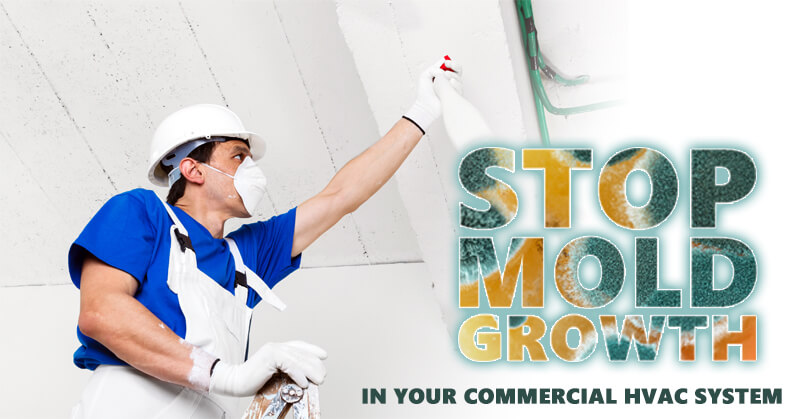Stop Mold Growth in Your Business HVAC System

Due to condensation, HVAC systems can be prime locations for mold growth, and these systems can distribute mold throughout the building. Visible mold always signals a potential problem in terms of health-related complications and damage to building structures. Stopping mold growth is imperative for sustaining good indoor air quality (IAQ).
HVAC Maintenance for Mold Prevention
It’s important to schedule regular cleaning and maintenance of your HVAC system. Make sure your contractor or technician checks the following for a thorough inspection.
Coils and Drain Pans
Air is dehumidified through cooling coils, and the condensate water drips into the drain pan before exiting through a deep seal trap. When the drain pan isn’t properly designed and maintained, standing water can accumulate, which creates a microbial habitat. In addition to proper sloping, cleaning the drain pan regularly is an important component of healthy IAQ.
Humidification and Dehumidification Equipment
Wet surfaces should be drained and periodically treated in order to prevent microbial growth. Your technician should also prevent duct linings from becoming moist from sprayed water.
Outdoor Air Dampers
Screens and grilles can become obstructed from mold growth that has developed from dust and debris. The technician should clean these surfaces regularly in order to remove dust build-up.
Air Filters
The air filters should be replaced regularly, either on a scheduled basis or because of the air filter’s pressure drop. Fans should also be shut off when changing the filter, in order to prevent air contamination. Your technician may recommend getting a higher-efficiency filter in order to improve your indoor air quality. Purchasing a compatible high-efficiency filter can also minimize energy use.
Ducts
While it’s normal to have some dust on duct surfaces, it’s important not to have dust on areas with restricted airflow, areas subject to condensation or moisture, and duct lining, as these locations are susceptible to contamination. The technician should fix any overly wet areas, such as the internal lining which can become chronically damp.
Return-Air Plenum
The space over the ceiling tiles is often used as a return-air plenum. Materials and supplies shouldn’t be in the plenum, as the area can become contaminated and disrupt airflow. All exhaust systems that pass through the plenum should be properly maintained in order to prevent leaks, as well as to prevent exhaust from entering the plenum. The technician should also check for condensation in the plenum areas and on pipes.
Cooling Towers
The chemical treatment and water quality should be periodically monitored to prevent microbial growth. It might also be necessary to physically clean the cooling towers in order to prevent the accumulation of sediment, and to install drift eliminators.
Air Intakes
The HVAC technician should check the areas where the outdoor air enters your HVAC system. He or she should also inspect any organic material that has accumulated in or near the HVAC intakes. Airborne fungal spores can become elevated when the intakes are near dumpsters, boxes, garbage cans, standing rainwater, paper, lagoons, ponds, and earth and vegetation that has been freshly disturbed.
Contact Anderson Air Corps for a thorough investigation of mold growth and to prevent mold from accumulating in the future. Doing so can protect your business as well as its occupants, and regular maintenance is the best way to keep mold at bay.
